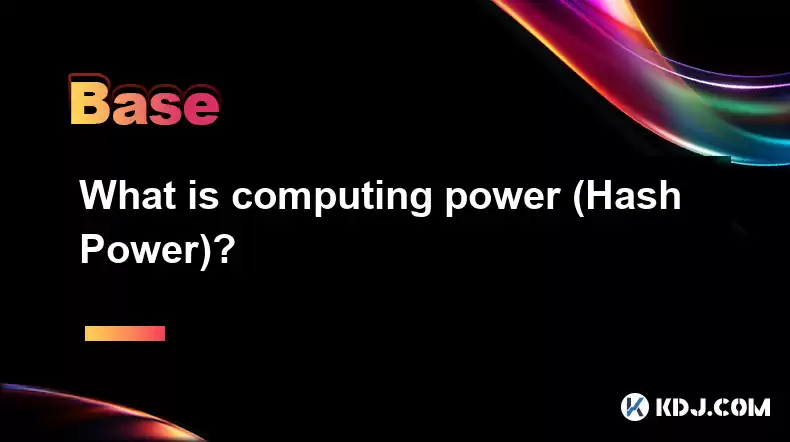-
 Bitcoin
Bitcoin $116700
0.24% -
 Ethereum
Ethereum $3973
4.34% -
 XRP
XRP $3.283
7.68% -
 Tether USDt
Tether USDt $1.000
0.01% -
 BNB
BNB $789.8
2.27% -
 Solana
Solana $176.2
3.31% -
 USDC
USDC $0.9999
0.00% -
 Dogecoin
Dogecoin $0.2238
5.14% -
 TRON
TRON $0.3389
-0.51% -
 Cardano
Cardano $0.7907
4.03% -
 Stellar
Stellar $0.4527
10.02% -
 Hyperliquid
Hyperliquid $41.07
4.27% -
 Sui
Sui $3.794
1.77% -
 Chainlink
Chainlink $19.49
10.40% -
 Bitcoin Cash
Bitcoin Cash $580.9
0.74% -
 Hedera
Hedera $0.2617
4.32% -
 Avalanche
Avalanche $23.41
3.67% -
 Ethena USDe
Ethena USDe $1.001
-0.03% -
 Litecoin
Litecoin $122.4
1.38% -
 Toncoin
Toncoin $3.364
1.49% -
 UNUS SED LEO
UNUS SED LEO $8.988
0.37% -
 Shiba Inu
Shiba Inu $0.00001295
2.82% -
 Uniswap
Uniswap $10.62
5.75% -
 Polkadot
Polkadot $3.922
4.46% -
 Dai
Dai $1.000
0.01% -
 Bitget Token
Bitget Token $4.494
2.15% -
 Monero
Monero $268.0
-1.30% -
 Cronos
Cronos $0.1523
3.68% -
 Pepe
Pepe $0.00001127
4.43% -
 Aave
Aave $285.4
4.85%
What is computing power (Hash Power)?
Cryptocurrency mining relies on hash power (computing power), measured in H/s, to solve cryptographic problems. Higher hash power increases block mining success, achieved via ASICs or mining pools, enhancing blockchain security.
Mar 15, 2025 at 03:50 pm

Key Points:
- Hash power, or computing power, represents the processing power dedicated to solving complex cryptographic problems in blockchain networks.
- It's measured in hashes per second (H/s), reflecting the speed at which a miner can perform these calculations.
- Higher hash power increases the probability of successfully mining a block and earning rewards.
- Different cryptocurrencies require varying levels of hash power due to their unique algorithms.
- Accessing hash power involves purchasing specialized hardware (ASICs) or joining mining pools.
What is Computing Power (Hash Power)?
In the realm of cryptocurrencies, computing power, often referred to as hash power, is the computational muscle employed to secure and maintain the blockchain. It's the raw processing power dedicated to solving complex mathematical problems, specifically cryptographic hash functions, that are essential to the mining process. The more hash power a miner possesses, the higher their chances of successfully adding a new block to the blockchain and receiving the associated rewards.
How is Hash Power Measured?
Hash power is measured in hashes per second (H/s), gigahashes per second (GH/s), terahashes per second (TH/s), petahashes per second (PH/s), exahashes per second (EH/s), and even higher units. This metric quantifies the rate at which a miner or mining operation can perform these cryptographic calculations. A higher H/s value signifies greater computational capability and, consequently, a higher probability of mining success. The specific unit used depends on the scale of the operation; individual miners might use H/s or GH/s, while large-scale operations utilize TH/s, PH/s, or even EH/s.
Why is Hash Power Important in Cryptocurrency Mining?
Hash power is crucial because it underpins the Proof-of-Work (PoW) consensus mechanism used by many prominent cryptocurrencies like Bitcoin. In PoW systems, miners compete to solve complex cryptographic puzzles. The first miner to solve the puzzle adds a new block to the blockchain and receives a reward, typically in the form of newly minted cryptocurrency and transaction fees. The difficulty of these puzzles adjusts dynamically based on the total network hash power, ensuring a consistent block generation time. A higher network hash power increases the security of the blockchain by making it computationally infeasible for attackers to alter past transactions.
How Does Hash Power Relate to Cryptocurrency Security?
A high network hash rate is directly correlated with the security of a cryptocurrency. A larger amount of computing power dedicated to securing the network makes it exponentially more difficult for malicious actors to launch 51% attacks, where a single entity controls more than half of the network's hash power and can potentially manipulate the blockchain. This emphasizes the importance of a decentralized and widely distributed hash power across many miners, preventing any single entity from gaining undue influence.
How Can I Access Hash Power?
Accessing hash power primarily involves two methods:
- Purchasing Specialized Hardware: Application-Specific Integrated Circuits (ASICs) are purpose-built chips designed for cryptocurrency mining. They offer significantly higher hash rates compared to general-purpose CPUs or GPUs. However, the initial investment can be substantial, and the profitability depends on factors like the cryptocurrency's price, energy costs, and the overall network hash rate.
- Joining a Mining Pool: Mining pools aggregate the hash power of multiple miners, increasing the collective chances of solving a block and sharing the rewards proportionally among participants. This reduces the risk of individual miners investing significant resources without earning any rewards. Joining a pool is generally more efficient for smaller-scale miners.
What are the Different Types of Hashing Algorithms?
Different cryptocurrencies utilize different hashing algorithms, each with varying computational complexities. Bitcoin, for example, uses the SHA-256 algorithm, while Ethereum (prior to the merge) employed Ethash. These algorithms determine the type of hardware best suited for mining a specific cryptocurrency. Some algorithms are more ASIC-resistant, meaning they are designed to be less susceptible to the overwhelming computational advantage of specialized ASICs, potentially allowing for more equitable participation with GPUs.
How Does Hash Power Affect Cryptocurrency Prices?
While not a direct correlation, high hash power can indirectly influence cryptocurrency prices. A robust and secure network, backed by substantial hash power, generally instills greater confidence in the cryptocurrency, potentially contributing to increased demand and higher prices. Conversely, a significant drop in hash power could signal vulnerability and potentially lead to price declines. However, numerous other factors, including market sentiment, regulatory changes, and technological advancements, play a much more significant role in determining cryptocurrency prices.
How Does the Difficulty Adjustment Affect Hash Power?
Many PoW cryptocurrencies incorporate a difficulty adjustment mechanism. This mechanism automatically adjusts the difficulty of solving the cryptographic puzzles based on the network's overall hash power and the average block generation time. If the network hash rate increases, the difficulty increases proportionally, maintaining a relatively consistent block generation time. Conversely, a decrease in hash power leads to a reduction in difficulty. This dynamic adjustment ensures the stability and security of the blockchain, regardless of fluctuations in the total network hash power.
What are the environmental concerns related to Hash Power?
The energy consumption associated with cryptocurrency mining, particularly PoW systems, is a growing environmental concern. The high energy demands of ASICs and the need for constant operation contribute to a significant carbon footprint. This has led to discussions about more energy-efficient consensus mechanisms, such as Proof-of-Stake (PoS), which require significantly less computational power. However, the transition to alternative consensus mechanisms involves considerable technological and economic challenges.
Common Questions:
Q: Is it profitable to mine cryptocurrencies with my home computer? A: Generally, mining cryptocurrencies with a home computer is not profitable for most common cryptocurrencies due to the high electricity costs and low hash rates compared to specialized ASICs or participation in large mining pools.
Q: What is the difference between hash rate and hash power? A: The terms are often used interchangeably, with hash rate referring to the speed of hashing, while hash power represents the overall computational capability. They are essentially describing the same thing from slightly different perspectives.
Q: Can I rent hash power? A: Yes, cloud mining services allow users to rent hash power without purchasing expensive hardware. However, due diligence is necessary to avoid scams. Thoroughly research the provider's reputation and security measures before committing.
Q: What happens if the hash power of a cryptocurrency network drops significantly? A: A significant drop in hash power could compromise the network's security, making it more vulnerable to attacks. The difficulty of mining might also decrease, potentially leading to a faster block generation rate.
Disclaimer:info@kdj.com
The information provided is not trading advice. kdj.com does not assume any responsibility for any investments made based on the information provided in this article. Cryptocurrencies are highly volatile and it is highly recommended that you invest with caution after thorough research!
If you believe that the content used on this website infringes your copyright, please contact us immediately (info@kdj.com) and we will delete it promptly.
- Bitcoin, Litecoin, and Avalanche: Decoding the Crypto Buzz in the Big Apple
- 2025-08-09 00:30:12
- Pengu Takes Flight: Can This Solana Meme Coin Conquer the Top 3?
- 2025-08-09 00:50:13
- Ethereum and Shiba Inu: Navigating the Bull Move
- 2025-08-09 00:35:12
- Navigating the Crypto Market in 2025: Smart Decisions for Meme Coin Investing
- 2025-08-09 00:55:55
- Punisher Coin: The Altcoin Ready to Punish Your Portfolio with Gains?
- 2025-08-08 22:50:16
- Mutuum Finance, Bitcoin Whales, and Binance: Decoding the Crypto Currents
- 2025-08-08 22:30:11
Related knowledge

Can you reuse a crypto wallet address?
Aug 08,2025 at 03:49pm
Understanding Wallet Addresses in CryptocurrencyA crypto wallet address is a unique identifier used to send and receive digital assets on a blockchain...

Are meme coins a good investment?
Aug 08,2025 at 11:36pm
Understanding Meme Coins and Their OriginsMeme coins are a category of cryptocurrencies that originated from internet humor or viral trends rather tha...

How are flash loans used?
Aug 08,2025 at 01:08pm
Understanding Flash Loans in Decentralized FinanceFlash loans are a unique innovation within the decentralized finance (DeFi) ecosystem, allowing user...

How to spot a rug pull?
Aug 08,2025 at 11:21pm
Understanding the Concept of a Rug PullA rug pull is a type of scam prevalent in the decentralized finance (DeFi) and cryptocurrency space where devel...

What is the environmental impact of crypto mining?
Aug 09,2025 at 12:28am
Energy Consumption of Cryptocurrency MiningThe environmental impact of crypto mining begins with its substantial energy consumption, primarily driven ...

What are common crypto trading strategies?
Aug 08,2025 at 12:42pm
Understanding Trend Following in Crypto TradingTrend following is one of the most widely adopted crypto trading strategies due to its simplicity and a...

Can you reuse a crypto wallet address?
Aug 08,2025 at 03:49pm
Understanding Wallet Addresses in CryptocurrencyA crypto wallet address is a unique identifier used to send and receive digital assets on a blockchain...

Are meme coins a good investment?
Aug 08,2025 at 11:36pm
Understanding Meme Coins and Their OriginsMeme coins are a category of cryptocurrencies that originated from internet humor or viral trends rather tha...

How are flash loans used?
Aug 08,2025 at 01:08pm
Understanding Flash Loans in Decentralized FinanceFlash loans are a unique innovation within the decentralized finance (DeFi) ecosystem, allowing user...

How to spot a rug pull?
Aug 08,2025 at 11:21pm
Understanding the Concept of a Rug PullA rug pull is a type of scam prevalent in the decentralized finance (DeFi) and cryptocurrency space where devel...

What is the environmental impact of crypto mining?
Aug 09,2025 at 12:28am
Energy Consumption of Cryptocurrency MiningThe environmental impact of crypto mining begins with its substantial energy consumption, primarily driven ...

What are common crypto trading strategies?
Aug 08,2025 at 12:42pm
Understanding Trend Following in Crypto TradingTrend following is one of the most widely adopted crypto trading strategies due to its simplicity and a...
See all articles

























































































